Endo, the blind horse, trying to find his way out listening to his owner’s voice
I think we all realize how hard it is to take care of a blind horse. In addition to the pity you feel for him (because it really is something horrible when someone loses their sight), you also have to be very careful when you are around him.

Just look at this beautiful white horse, named Endo, trying to find his way out listening to his owner’s voice. Endo is an Appaloosa gelding who had his eyes removed because he suffered from equine recurrent uveitis also known as “moon blindness”. Bacteria, fungus, viruses, parasites, pollen, vitamin deficiencies, autoimmune deficiencies, and physical injury all may be a cause of moon blindness. The leptospirosis bacteria and the bacteria that cause strangles maybe two of the more common bacterial causes. But the good part is that it is known that this disease is not contagious and cannot be passed from horse to horse.

And because the process of losing sight can be frightening for the animal, bring the horse into a corral or stall. This will keep it out of harm’s way and allow you to closely monitor it. Keep other animals away, except perhaps for a single buddy. What is important, don’t sneak up on the horse. Never go up to your blind horse without making a noise as you approach it. Start talking or making noises before you enter its stall.

Most horses adapt well to vision loss but still require special management. Adjustment to vision loss is helped if the horse is given a predictable daily routine. Feeding should be done at the same time and in the same place every day. Freshwater should always be available. If the horse is turned out, it should be led out along the same path each time and released at the same spot.
Over several weeks, acceptance of vision loss and adjustment to blindness occurs in most innately calm horses, and behavior becomes settled and predictable
